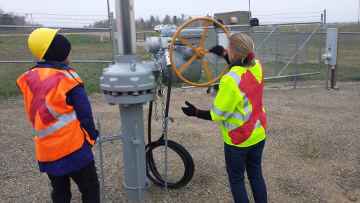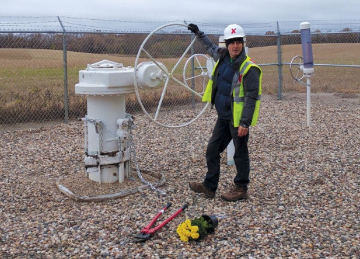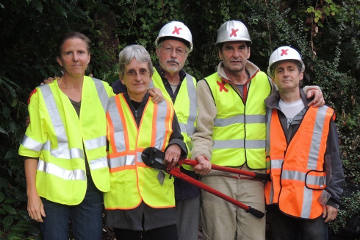Valve Turners
Who and What
In October 2016, five men and women coordinated to shut down all five main pipelines bringing Alberta tar sands crude into the United States. In succession, Emily Johnston, Annette Klapstein, Michael Foster, Leonard Higgins, then Ken Ward called pipeline companies shortly before turning safety shut-off valves on Enbridge’s lines 4 & 67, TransCanada’s Keystone, Spectra Energy’s Express, and Kinder-Morgan’s TransMountain pipelines. They then awaited arrest, submitting to months of court dates and even jail time.
The action was very simple. The group located shut-off valves, where they could affect oil flow through otherwise inaccessible buried pipelines. (In some cases, these sites expose actual piping, which Ruby and Jessica leveraged to sabotage the Dakota Access Pipeline.) Valve sites are typically guarded by nothing more than a chain link fence. To access the shut-off valve controls, each Valve Turner cut a lock on the enclosure fence, then a lock on the valve wheel. After a few minutes of manual labor each, the actionists stopped the flow of, in total, nearly 30 barrels of oil every second. (Higgins made his job even easier by flipping an electronic switch from “remote” to “local,” which triggered hydraulics to close the valve for him.)
The most difficult part of the action was steeling themselves to commit felonies and face the consequences. At ages 50 to 64, their sense of responsibility had to overcome many decades of indoctrination that activists must only work within the confines of the law.
Strategy and Goals
The Valve Turners have given up on politicians saving us, stating on their action strategy page that “What’s needed is a strong movement, and we know that bringing that movement to life and power requires visceral and energizing acts of conscience that embody the change we seek.” They tailored their action accordingly, to raise awareness of our dire situation and inspire urgently needed action.
Others had closed valves on four occasions: two aboveground (in Québec and in Ontario) and two belowground. Though prior actions had already received some coverage of the successful tactic, the Valve Turners hoped that their larger, coordinated action might draw more attention. They hoped to push the media, and even US presidential candidates Clinton and Trump, to discuss climate disruption on a national scale. They hoped to uplift the hearts of movement participants, by demonstrating the moral duty to act “even when there is no certainty of stopping the harms of climate change.”
In this spirit, the action wasn’t meant to have much material impact. It isn’t clear what tangible actions the Valve Turners hoped to inspire in others, but one of their statements suggests a strategy of attrition: “We showed that it CAN and MUST be done - over and over, until the fossil fuel companies get the message that they are no longer going to profit by destroying the planet we need to live on.”
They hoped to have the opportunity to present at least one “necessity defense” in court, to “stand without fear and explain in cogent language the catastrophe before us and the necessity to act, in front of a jury of our peers.” They wanted to “set an example of personal strength and responsibility we believe is critical to winning this fight,” and to embolden others by establishing a precedent of legal clemency for climate direct action.
They also harbored a long-shot hope that President Obama would use the opportunity to declare a climate emergency and keep the tar sands valves closed.
Impact
Investments and costs
Their work can be divided into two phases: first, actually closing the valves; then leveraging media coverage and court trials to raise awareness and inspire others.
In the first phase, the group spent about five months and $12-14,000 planning and executing the action. Between the five Valve Turners plus their support crew, perhaps they invested 35 person months.
In the second phase, they incurred “large bills” for fines, legal fees, and travel expenses to court dates. Their Legal Defense Fund estimated that $50,000 would be needed for legal fees and expert witness expenses—though the Civil Liberties Defense Center provided at least some pro bono defense, and no expert witnesses wound up testifying, so perhaps the ultimate cost was less.
The Valve Turners and their arrested support crew, legal defense, and supporters presumably spent significant time preparing for, traveling to, and appearing at trials.
Michael Foster received a one year prison sentence, and Ken Ward 30 days of community service. The rest of the group received deferred imprisonment (increasing risk of penalties if they engage in further civil disobedience), or no prison time at all.
Material effectiveness
Though the action wasn’t meant to have much material impact, it did halt pipeline transport of about 767,000 barrels1, roughly 7.5% of daily US imports and 3.75% of daily consumption. (The backed up oil probably moved to market by rail at a higher premium.) Although the fight against the Dakota Access Pipeline was different in many ways, it’s interesting to compare returns on investment:
Return on investment: barrels of oil stopped per person month, and barrels stopped per dollar
Hover for a few seconds over underlined headers for explanations
| Who | Target | Tactic | Barrels stopped | Person months | BBLS/p-m | Money | BBLS/$ |
|---|---|---|---|---|---|---|---|
| Valve Turners | Tar sands pipelines | Civil disobedience | .77 million | ~35 | 21,900 | $12-$14,000 | 58 |
| #NoDAPL | DAPL | Civil disobedience | 45 million | > 15,000 | < 3000 | > $20 million | < 2.25 |
| Ruby & Jessica | DAPL | Ecosabotage | 30 million | 10 | 3,000,000 | ~$3000 | 10,000 |
Read our comparison of these campaigns: Pipeline Activism and Principles of Strategy
These rough numbers suggest the Valve Turners were at least seven times more efficient than #NoDAPL in time invested, and twenty-five times more efficient per dollar. This makes sense, since the Valve Turners employed initiative and surprise.
Though the Valve Turners were less than 1% as efficient as Ruby and Jessica, they could easily have come closer had material impact been their goal. They could have leveraged their knowledge of the system to close valves up and down the pipelines for months, perhaps even rupturing downstream sections of pipe after shutting off the flow. By disappearing before the police arrived, they’d have been free to hit and run again and again, greatly increasing their returns on investment.
Symbolic and persuasive effectiveness
However, the Valve Turners weren’t trying to maximize pipeline disruption. They primarily aimed to raise awareness, prompt discourse, and spark further action.
The group received much media coverage, mostly from progressive and left-wing websites and media, including large outlets such as The Nation, Democracy Now, and The Intercept. They did get some coverage from the mainstream Associated Press and Reuters, and Bill McKibben wrote an op-ed for L.A. Times. Unfortunately, it doesn’t seem that the cumulative coverage broke into the national media cycle in the way they’d hoped, nor were Clinton and Trump forced to discuss climate disruption. As expected, President Obama did not order the valves kept closed, but the action may have helped persuade him to reject Keystone XL.
No ongoing campaign has yet emerged to force shutdown the pipelines through direct action such as repeatedly turning valves. But the Valve Turners inspired a Minnesota action in February 2019; perhaps a large, persistent campaign is gestating.
Not one of the defendants was able to present a necessity defense.
Ultimately, the only measure of effectiveness—that by which future generations will judge us—is whether and how fast we stop fossil fuels. Raising awareness can contribute indirectly, but so far, phase two of the Valve Turners’ plan hasn’t been as successful as the action itself. But they introduced a simple yet effective tactic to many people; their efforts may yet pay off in widespread material resistance.
Unintended effects
The CARVER matrix for target selection considers unwanted potential side effects of an action. The pipeline companies accused the Valve Turners of risking pipeline ruptures, but unsurprisingly, the corporations lied. To minimize risk, the Valve Turners chose isolated control valves away from towns, and at least ten miles downstream from the nearest pumping station. Further, they called each pipeline operator fifteen minutes in advance so they could initiate safe shutdown procedures.
The actions of the Valve Turners, along with those of Standing Rock, have given states an excuse to criminalize environmental protest. Of course, such laws produce a side effect the corporations and their government supporters don’t want. Activists will weigh severe punishment for symbolic civil disobedience against the relatively minimal risk of capture and punishment for ecosabotage, and may increasingly turn to materially effective action.
Conclusion
Like many, the Valve Turners struggle with dishearteningly conflicting beliefs: a mass movement is necessary, yet is extremely unlikely. The clearest route to resolving the tension is to accept the infinitesimal likelihood of a mass movement for the necessary radical change; then to devise a strategy suited to that reality. The final two paragraphs of the group’s Action Strategy page capture the dilemma absent such resolution:
If we can convince a random jury of citizens to agree that the climate situation is sufficiently desperate that shutting off a pipeline is excusable, it will be a vindication that telling the truth of the dire situation we are in—with openness and compassion, with the personal commitment to back it up—is a winning strategy. That outcome, we know, is unlikely.
But if convicted, the valve turners will be a powerful example of the moral fortitude required in the face of this challenge.
They express pessimism and even defeatism, expecting failure but taking solace in spiritual purity. However, once activists give up hope for a mass movement, they can focus on effective actions and on recruiting additional serious actionists. The Valve Turners came close; though they achieved neither significant material impact nor the symbolic impact for which they’d hoped, they did disseminate knowledge of a simple, effective tactic. Since turning valves can disrupt operational infrastructure, a small number of people could substantively hamper business as usual, and even trigger cascading failure.
Success is the strongest recruitment tool. A prolonged campaign repeatedly halting oil flows may not win support from fence-sitters, but will mobilize the core who want effective action. Employing tactics for maximum material impact will build a smaller but stronger movement. Then we can justifiably shift from defeatism to optimism.
- Read our comparison of the Valve Turners, #NoDAPL, and Ruby Montoya and Jessica Reznicek: Pipeline Activism and Principles of Strategy
- Listen to an interview with the Valve Turners
-
According to Climate Direct Action, the TransMountain pipeline sabotaged by Ken Ward didn’t have oil flowing that day anyway. The other pipelines have maximum capacities of 792,000 bpd (each of Enbridge Lines 4 and 67), 280,000 bpd (Spectra Energy Express), and 590,000 bpd (TransCanada Keystone), for a total of 2,454,000 bpd or 102,250 barrels per hour. Assuming all the flows were stopped for seven or eight hours, then 7.5 * 102,250 = 766,875 barrels. Some accounts claim the action halted 15% of daily US import, which would amount to 1.5 million barrels, but the derivation of this figure isn’t given. ↩︎
Consider supporting our work by joining our mailing list below, sharing & "liking" this page, and following us on social media. You may freely republish this Creative Commons licensed article with attribution and a link to the original.




